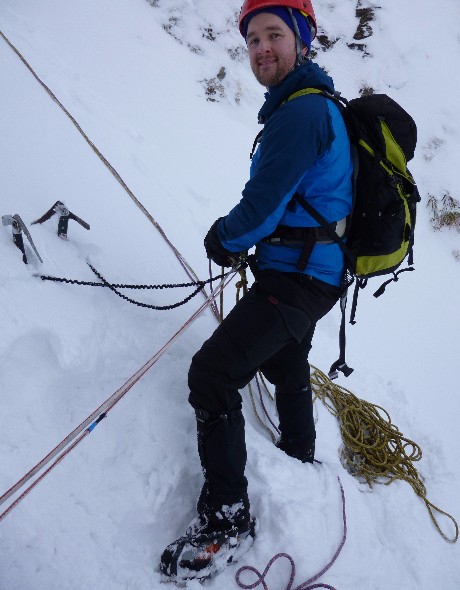Crampons are essential kit for exploring Scotland's mountains when they're covered by snow or ice. A crampon is a traction device attached to the base of your boot to aid travel in winter conditions. There are different types of crampons for different uses. They're an important investment, so make sure you buy wisely and get something designed for the job you want them to do and compatible with your boots.
To help people make the correct choice, a rating system has been established:
Designed for walking on moderately angled snow and ice. They normally have 10 or 12 points but may not have any forward-facing front points. The front and heel sections are connected by a flexible metal strip and use either a fully strapped or flexible plastic cradle/strap combination for attachment.
These usually have 10 downward-facing and 2 forward-facing points and are hinged below the instep. Attachment is with cradle/strap or (more commonly) cradle/heel-clip combination.
Also known as technical crampons, these are a rigid construction (usually 12 point) and designed for use on steep ice.

A wide range of devices are available which fit over boots, shoes or even trainers and which offer traction on ice. It is important to realise that while many of these are good for icy pavements or easy-angled footpaths, they are not crampons and are not an adequate alternative, and are unsafe on steep or rough terrain.
Read more about 'grippers' v crampons in this 2014 article from Scottish Mountaineer.
Take your boots to a professional outdoor retailer such as Tiso, Cotswold, Nevisport or Craigdon, where staff will advise you on which crampon is compatible to your boots and chosen activity.
In Scotland, it is not unusual to experience air temperatures around zero. The snow will make great snowmen and snowballs, but it will also tend to 'ball up' under your foot if your crampons are not fitted with anti-balling plates. This balling up gives real potential for a slip.
Anti-balling plates are made of plastic or rubber and are fitted to the base of the crampon to reduce the problem of snow accumulating. We strongly recommend you use them.
Always carry crampons when there is snow on the hills, even if you think you may not need to use them. Wear crampons whenever your boots don't create steps in the snow easily and remember to put them on before getting onto ground where you would be insecure without them. Accidents can occur as a direct result of crampons coming loose. Avoid wearing baggy trousers on which crampons can snag and beware of anything hanging down from your waist.
Adopt a gait that has the legs farther apart than normal, and practice using your crampons in a safe, controlled environment. You should flex your ankles so that all of the downward points bite. Avoid stamping or dragging your feet. Develop the technique of placing your feet firmly and confidently with each step. Check your crampons are still tightly fitted a few minutes after setting off. Check out our ‘Winter Essentials’ DVD for more comprehensive information on the use of crampons.
Watch this video for tips on climbing - or descending - a hill with crampons.